
The effect of lengthening manifold primaries S2000
wylliezx9r - 21/3/13 at 09:14 PM
For all you boffins out there.
To make an off the shelf manifold fit my S2000 F20C engine I am going to have to lengthen the primaries. Does anybody know what effect this is going
to have ? I'm guessing its going to move the torque lower or higher in the rev range ? Or is it just going to choke the engine completely ?
ATB Dan
daniel mason - 21/3/13 at 09:26 PM
the standard system is a very highly tuned setup,and the engines are very sensitive to exhaust changes..if you dont spend money on a good tuned setup
you will almost definately loose a chunk of performance!
franky - 21/3/13 at 09:42 PM
quote:
Originally posted by wylliezx9r
For all you boffins out there.
To make an off the shelf manifold fit my S2000 F20C engine I am going to have to lengthen the primaries. Does anybody know what effect this is going
to have ? I'm guessing its going to move the torque lower or higher in the rev range ? Or is it just going to choke the engine completely ?
ATB Dan
Well by going higher or lower you're hitting all bases
You'll end up with more midrange as a rough rule of thumb, depends on other factors though too.
You won't choke the engine at all, you're talking a very very small percentage of perceptible change if any.
wylliezx9r - 21/3/13 at 09:54 PM
quote:
Originally posted by franky
quote:
Originally posted by wylliezx9r
For all you boffins out there.
To make an off the shelf manifold fit my S2000 F20C engine I am going to have to lengthen the primaries. Does anybody know what effect this is going
to have ? I'm guessing its going to move the torque lower or higher in the rev range ? Or is it just going to choke the engine completely ?
ATB Dan
Well by going higher or lower you're hitting all bases
You'll end up with more midrange as a rough rule of thumb, depends on other factors though too.
You won't choke the engine at all, you're talking a very very small percentage of perceptible change if any.
This is pretty much what I concluded with the limited amount of research that I have done. I'm not going to be changing the length ratio between
the four pipes, I'll be adding the same length to all four.
Thanks
SeanStone - 21/3/13 at 09:57 PM
Supercharge it afterwards and you needn't worry 
unijacko67 - 21/3/13 at 10:05 PM
Read this chaps article on how to make your own, really good read. Sound bloke and can supply bends I believe.
http://www.ojzengineering.co.uk/
[Edited on 21/3/13 by unijacko67]
Neadles - 21/3/13 at 10:31 PM
You may see a slight issue with a reduction in your scavenge effect across the exhausting cylinders. As you know Honda engines have high flowing heads
and lengthening the primaries will reduce the effect of the low pressure created by the escaping gases aiding the removal of the combustion process.
Alternative FI will sort it out  This is a very precise sciences with high powered Honda engines but since its in a small chassis the change if
power will not be a real issue I would say.
This is a very precise sciences with high powered Honda engines but since its in a small chassis the change if
power will not be a real issue I would say.
Bare - 22/3/13 at 01:56 AM
Sigh.. IF you knew what you were doing you wouldn't be asking.
When you have the knowledge required to redesign it ...then you might not :-)
Want Mo' power ? insert some crap Rover v8 lump.
snapper - 22/3/13 at 06:57 AM
Primary length, secondary (if you have a 4,2,1) and overall length to collector all have an effect.
In reality it will only effect a small specific rev range and therefore will not make a noticeable difference on the road
I did the maths on my Pinto manifold and have it set for a slight torque advantage but this also required a tuned inlet manifold length
If it realy bothered you and you have a 4,1 playing with the collector diameter and length plus where the silencer starts can restore the effect
But IMHO don't obsess
Oddified - 22/3/13 at 09:11 AM
As said above, the pipe length to the first silencer also effects it, so when it's fitted in a different car with changed silencer position/s
it's all changed any way.
As a rule of thumb lengthening the primarys will move the power band down the rpm slightly (unless your changing them a lot?).
The fuel map will probably need a few minor tweeks though (it will need more fuel in the area of where the torque has been moved to and less where it
used to be).
Ian
PeteS2k - 22/3/13 at 09:37 AM
Mine's running on a standard intake, DTA ECU, 4-1 manifold built to fit my engine bay (with primaries too short according to the calcs, but equal
length). It still made 240bhp max when being mapped, and drives really well.
Of course, perhaps it could have made a lot more, with better mid-range etc, with a more optimised exhaust. But then, the other accepted fact with
this engine is that it's difficult to make any significant gains without major work?
I did try to work out the theoretical pipe lengths - then compared them to the OEM manifold. At which point I just left it to the exhaust manufacturer
- the OEM primaries are all over the place! Which I thought odd for an engine apparently so sensitive?
wylliezx9r - 22/3/13 at 09:44 AM
quote:
Originally posted by Bare
Sigh.. IF you knew what you were doing you wouldn't be asking.
When you have the knowledge required to redesign it ...then you might not :-)
Want Mo' power ? insert some crap Rover v8 lump.
What the f*ck are you on about ? Am I missing something ?
MikeRJ - 22/3/13 at 10:44 AM
quote:
Originally posted by wylliezx9r
quote:
Originally posted by Bare
Sigh.. IF you knew what you were doing you wouldn't be asking.
When you have the knowledge required to redesign it ...then you might not :-)
Want Mo' power ? insert some crap Rover v8 lump.
What the f*ck are you on about ? Am I missing something ?
God knows, that confused me as well, not even sure who it's directed at?
Longer primaries will tend to favour low/mid range torque, but often will have minimal impact on peak HP. A friends tarmac rally Peugeot 205 is
producing ~280bhp from a very highly tuned Mi16/GTi6 hybrid engine, and uses extremely long primaries. In fact they end somewhere around where the
back seat would be if it had one.
However, it will almost certainly to need changes to the the fueling to optimise the power output after changing the manifold.
[Edited on 22/3/13 by MikeRJ]
wylliezx9r - 22/3/13 at 10:58 AM
quote:
Originally posted by MikeRJ
quote:
Originally posted by wylliezx9r
quote:
Originally posted by Bare
Sigh.. IF you knew what you were doing you wouldn't be asking.
When you have the knowledge required to redesign it ...then you might not :-)
Want Mo' power ? insert some crap Rover v8 lump.
What the f*ck are you on about ? Am I missing something ?
God knows, that confused me as well, not even sure who it's directed at?
Longer primaries will tend to favour low/mid range torque, but often will have minimal impact on peak HP. A friends tarmac rally Peugeot 205 is
producing ~280bhp from a very highly tuned Mi16/GTi6 hybrid engine, and uses extremely long primaries. In fact they end somewhere around where the
back seat would be if it had one.
However, it will almost certainly to need changes to the the fueling to optimise the power output after changing the manifold.
[Edited on 22/3/13 by MikeRJ]
I have a fully mappable ECU (Omex 7100) it will be going for a rolling road session before being driven on the road. I'm feeling quite posotive
about doing this now, I really can't afford the £1000 to get a custom manifold built at the moment.
Thanks for all the comments
PhillipM - 17/6/13 at 12:37 AM
quote:
Originally posted by MikeRJ
Longer primaries will tend to favour low/mid range torque, but often will have minimal impact on peak HP. A friends tarmac rally Peugeot 205 is
producing ~280bhp from a very highly tuned Mi16/GTi6 hybrid engine, and uses extremely long primaries. In fact they end somewhere around where the
back seat would be if it had one.
It depends on how long you can go really, if you can add enough extra length you get to the next set of resonances (which are often stronger with the
longer manifold), anyway, you'll often run out of space before you get enough length in, we went for maximum midrange for ours and the manifold
looks like some sort of accident in a pipe factory.
Rocket_Rabbit - 4/3/16 at 11:39 PM
Drag up an old thread, but still relative.
I had mine rolling roaded at EFI parts. Also had some wiring done and I can't stress at how good Chris is.
The car made 214bhp with this exhaust. A run was performed with and without the silencer - no difference.
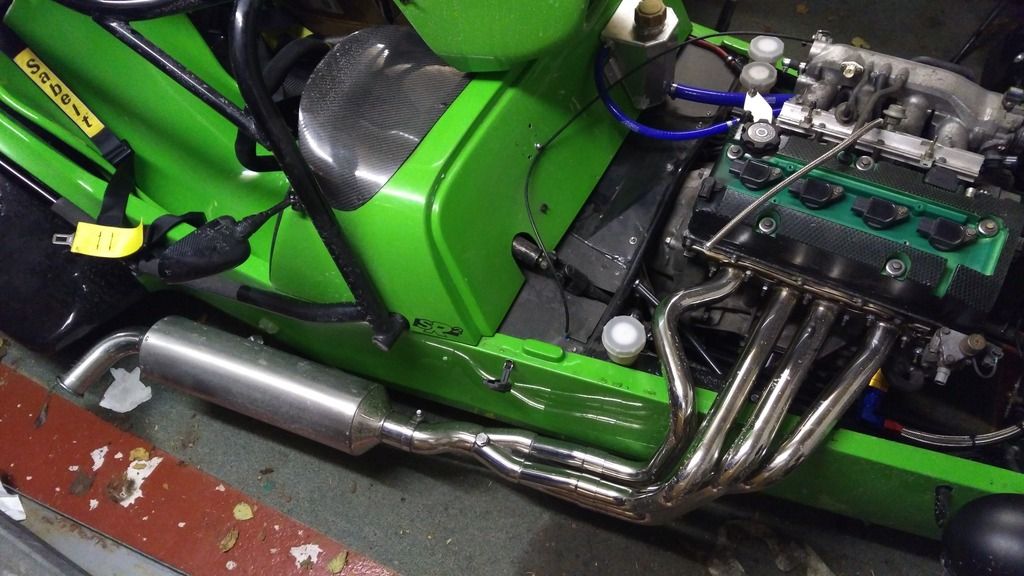
daniel mason - 4/3/16 at 11:48 PM
Is that a rwhp figure?
Rocket_Rabbit - 5/3/16 at 08:54 AM
quote:
Originally posted by daniel mason
Is that a rwhp figure?
Nope at the flywheel.
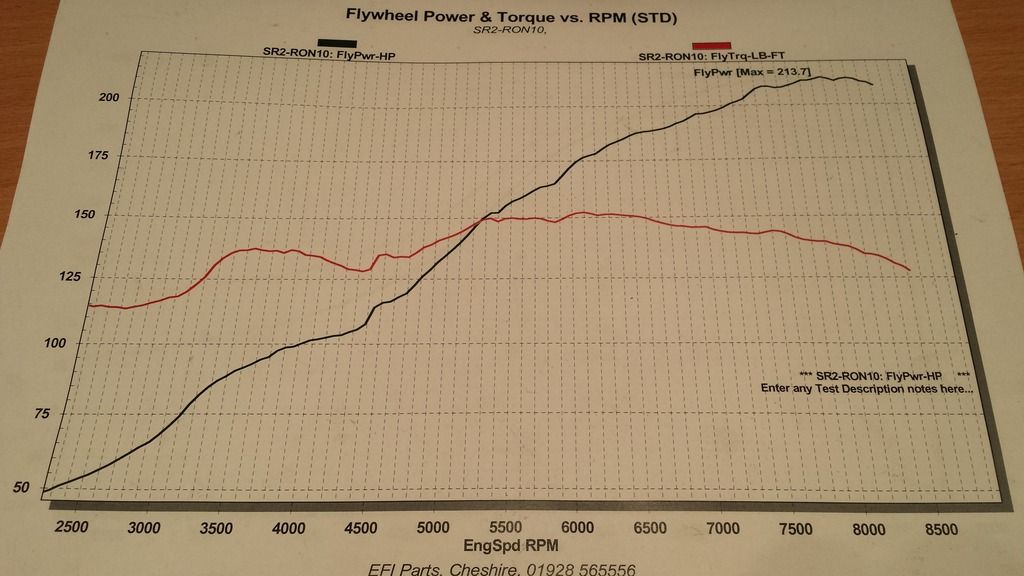
daniel mason - 5/3/16 at 08:56 AM
Looks a superb install!
Rocket_Rabbit - 5/3/16 at 09:04 AM
quote:
Originally posted by daniel mason
Looks a superb install!
This happened after 3 miles of driving, including the RR session:
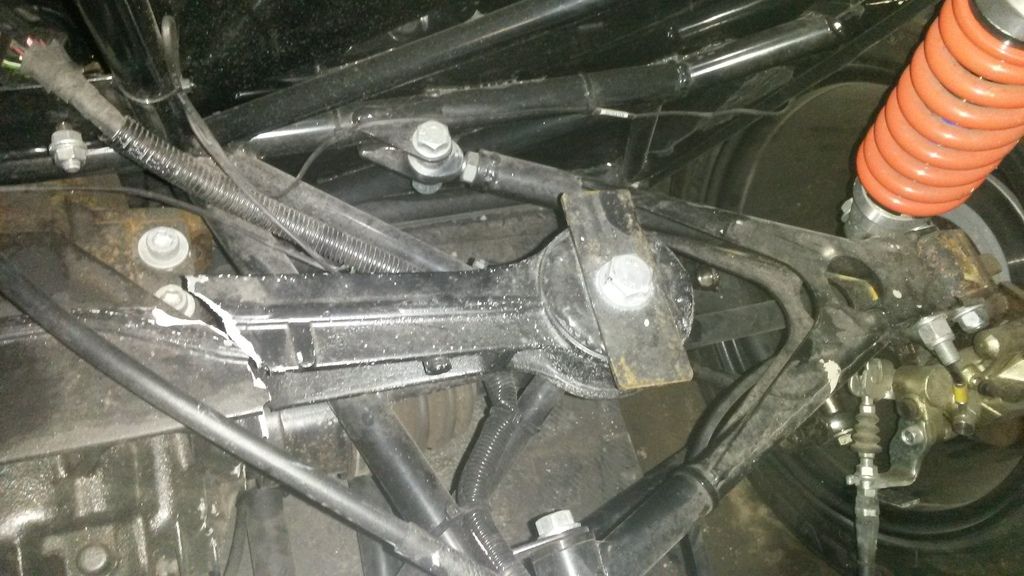
I will be redesigning the rear diff mounting structure and using an RX8 diff. Roadrunner have been sh1t TBH. They built the car and supplied the
reconned diff. This type of thing can happen after 'extreme' use which in my case was driving it up and down an access road and then onto a
trailer.
I don't want to corrupt the thread, so i'll post more about it elsewhere 
Looking at the exhaust, I'm convinced it's the 4-2-1 section that is costing power. I do have a 4-1 collector so I might get the exhuast
modified to accept that.
SteveWallace - 5/3/16 at 10:21 AM
quote:
Originally posted by daniel mason
the standard system is a very highly tuned setup,and the engines are very sensitive to exhaust changes..if you dont spend money on a good tuned setup
you will almost definately loose a chunk of performance!
Just out of interest, what sort of percentage performance difference are we talking about when comparing a very well designed (and expensive) set of
primaries with a low cost version that has been made to look right but without referring to someone who has a PhD in gas flow dynamics?
Are we talking extracting the last fraction of performance that could shave fractions of a second off lap times, or something where you get in the car
for a blat in the countryside at the weekend and go "I wish I'd spent more on exhaust design"?
daniel mason - 5/3/16 at 10:27 AM
You could make one out of scaffolding tube and it would still go like a stabbed rat with an f20c in it. But it would be a fair chunk lost.
Per lind on here knows his stuff regarding the f20c! User name PWL
SteveWallace - 5/3/16 at 10:51 AM
I was thinking more in general terms than for the specific engine that the OP mentioned
russtik - 5/3/16 at 02:22 PM
quote:
Originally posted by Rocket_Rabbit
This happened after 3 miles of driving, including the RR session:

I will be redesigning the rear diff mounting structure and using an RX8 diff. Roadrunner have been sh1t TBH. They built the car and supplied the
reconned diff. This type of thing can happen after 'extreme' use which in my case was driving it up and down an access road and then onto a
trailer.
Hmmm, that looks familiar... (clearly a design flaw in the SR2)
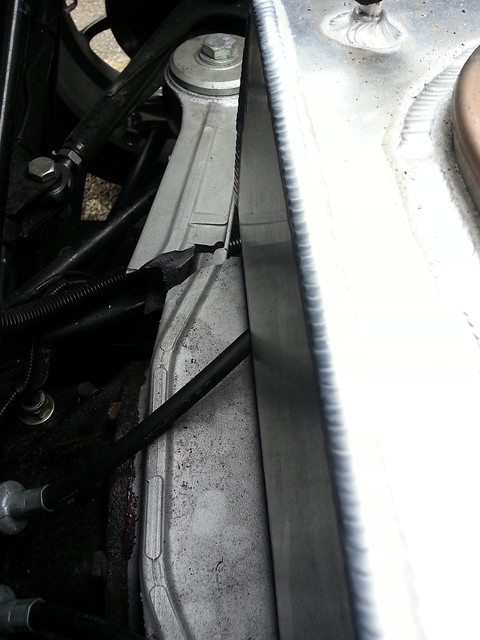
sdh2903 - 5/3/16 at 03:59 PM
That's definitely a mounting point issue as they've gone in nigh on exactly the same spot. How comes roadrunner have decided to bolt them
down rather than hanging as per standard fit and also mnr/westfield? Looks like a couple of spacers required to prevent the mounting arms being under
stress perhaps?
Talon Motorsport - 5/3/16 at 04:57 PM
Off topic some what I know and I'm sorry....The MX5 cast ali cover and arms is designed to fail at that point it has two notches cast in to the
arms. The diff when mounted in the MX5 floats within the sub frame on the rubber bushes and the nose is connected to the back of the gearbox by the
ali back bone (the correct name of it escapes me just now). You need to solidly mount the nose of the diff and replace the rubber bushes in the arms
with some thing a lot stiffer.
I how ever did away with the cast cover all together in the TMXR and made the MX5 diff fit in to the standard Roadster suspension cage with this
fabricated item which gives four mounting points.
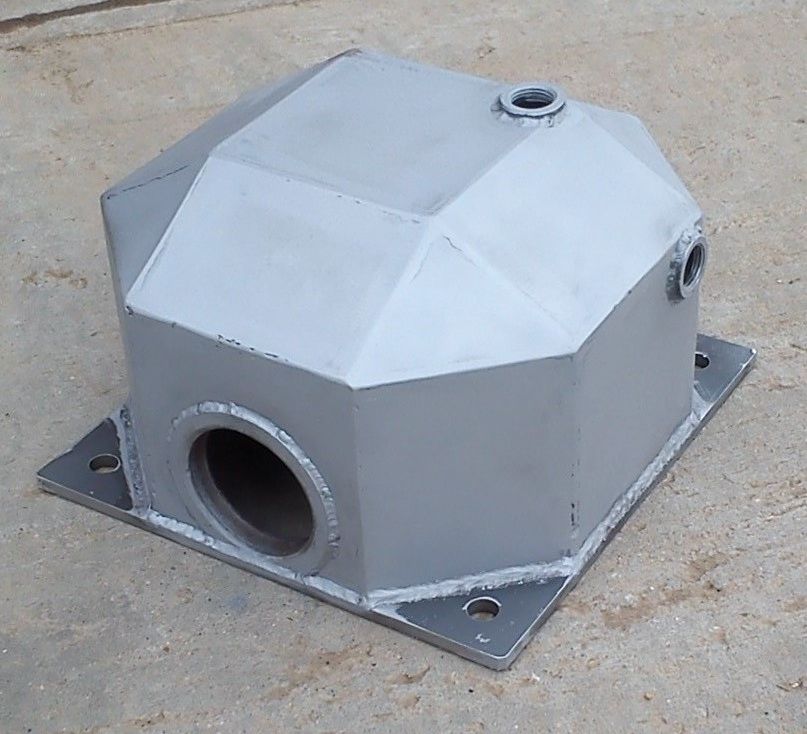

[Edited on 5/3/16 by Talon Motorsport]
snapper - 5/3/16 at 07:12 PM
I'm just going to add a bit more to the exhaust parts of the thread
Working with exhaust primary lengths and diameters is a very exact science, it takes into account not just the exhaust but also the inlet tract length
from the end of the bell mouth to the valve head, the cam duration and I believe the stroke.
The guy who did the calculations for me on Turbosports forum provided ideal inlet tract length and the length, diameters of the primaries and the
collector with different lengths for the 1st 2nd 3rd and 4th harmonics he also said which worked best for my engine
I was lucky the Pinto 4 branch I had fitted neatly into one of the preferred ranges, the collector was ok and the can near enough, pipe size was to
large
I did not loose any bhp but didn't gain much
In any case the ideal exhaust would be built to deliver the torque at the desired revs and will only be at one small rev band
For me I want to enhance mid range torque as this is where I mostly am, brief excursions to high revs doesn't give me any advantage on the road
especially with high lift long duration cams, you want to fill the off cam gaps to get a better driving experience
IMHO
SPYDER - 5/3/16 at 08:41 PM
It wouldn't be easy to make the perfect manifold for the F20 engine. To achieve the excellent HP figure they surely must have tuned the system
toward high revs. To match the variation in cam timing given by the VTEC system I would be expecting the sort of variable tuned length systems used on
some superbikes. Think "EXUP" or "HIVEX" to name the Yamaha and Honda versions. But Honda don't deem it necessary for the
F20. In fact, I can't think of one car engine using this concept.
But loads have used a similar system on the inlet side.
Does this indicate that tuned lengths are more beneficial on induction than on exhaust?
Rocket_Rabbit - 6/3/16 at 10:57 AM
quote:
Originally posted by SPYDER
It wouldn't be easy to make the perfect manifold for the F20 engine. To achieve the excellent HP figure they surely must have tuned the system
toward high revs. To match the variation in cam timing given by the VTEC system I would be expecting the sort of variable tuned length systems used on
some superbikes. Think "EXUP" or "HIVEX" to name the Yamaha and Honda versions. But Honda don't deem it necessary for the
F20. In fact, I can't think of one car engine using this concept.
But loads have used a similar system on the inlet side.
Does this indicate that tuned lengths are more beneficial on induction than on exhaust?
No superbike has 'variable length' per se, but a restrictor/throttle valve in the exhaust to increase back pressure at low rpm.
On my GSXR600 it is called the SET valve. One of the first things I did to it was bin it!
Of course the inlet is indeed important and variable volume inlets have been around for ages. DBW throttles take it a stage futher by turning the
accelerator pedal into a torque demand pedal leaving the ECU to decide what position the throttle pate needs to be at in order to offer up the maximum
enigne efficiency at a specific RPM.
Rocket_Rabbit - 8/3/16 at 12:19 PM
I was fortunate enough to get a RR printout from a standard S2000 on the same RR as mine was tuned on:
Mine:

S2000:
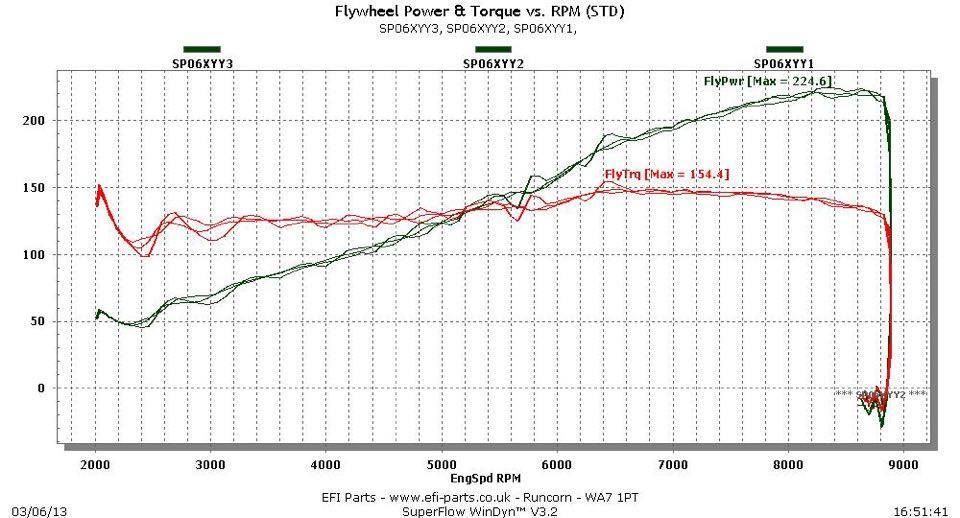
If you look at the torque curve, after 6500rpm on mine, it drops down a fair bit whereas on the OEM car it remains flat.
I am pretty sure this is indicative of a restriction and not a lack of scavenging effect which at high rpm, really shouldn't be as vital.
Opinions welcomed.








